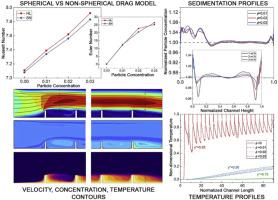Multiphase Eulerian–Eulerian study on sedimentation and thermal transport of Ti3C2Tx MXene nanofluids in a heated microchannel
Q1 Chemical Engineering
引用次数: 0
Abstract
Sedimentation plays a critical role in accurately assessing the heat transfer performance of microchannel-based thermal systems. This study investigates the sedimentation behavior of MXene–water nanofluid (MWNF) in a bottom-heated 2D microchannel with and without internal fins using the two-phase Eulerian–Eulerian (EE) approach. The analysis also focuses on the impact of particle concentration (ϕ), internal fins, and sphericity-sensitive drag models such as Haider–Levenspiel (HL) and Schiller–Nauman (SN) on heat transfer performance and nanoparticle (NP) dynamics. Results show that the HL model captured the behavior of 2D Ti3C2 MXene (TMX) NPs more accurately, where SN overestimated the average Nusselt number (Nu) by 1.15 % and the Euler number (Eu) by 5.1 %, for higher ϕ. Finned microchannels significantly influence NP sedimentation, which increased the local ϕ by 49.83 % compared to unfinned configurations and disrupted the symmetry of particle distribution across the microchannel. While both drag models estimated similar Nu at low concentrations, deviations widen with increasing ϕ, particularly in finned geometries. At ϕ = 3 wt.%, Nu enhancement reached 15.78 % with HL versus 13.09 % with SN, reinforcing the superiority of the HL model in microscale simulations involving 2D materials. The findings also demonstrated that while ϕ influences heat transfer, its effect is moderated by fin-induced thermal disruptions, highlighting the need for coupled consideration of NF properties and internal geometries in microscale heat exchanger design.

Ti3C2Tx MXene纳米流体在加热微通道中沉积和热输运的多相欧拉-欧拉研究
沉积在准确评估基于微通道的热系统的传热性能方面起着至关重要的作用。本研究采用两相欧拉-欧拉(EE)方法研究了mxene -水纳米流体(MWNF)在带和不带内翅片的底部加热二维微通道中的沉积行为。该分析还侧重于颗粒浓度(ϕ),内部翅片和球形敏感阻力模型(如Haider-Levenspiel (HL)和Schiller-Nauman (SN))对传热性能和纳米颗粒(NP)动力学的影响。结果表明,HL模型更准确地捕获了2D Ti3C2 MXene (TMX) NPs的行为,其中SN对平均努塞尔数(Nu)的高估幅度为1.15%,欧拉数(Eu)的高估幅度为5.1%。鳍状微通道显著影响NP沉降,与非鳍状微通道相比,其局部ϕ增加了49.83%,并破坏了微通道中颗粒分布的对称性。虽然两种阻力模型在低浓度下估计的Nu相似,但偏差随着φ的增加而扩大,特别是在鳍状几何形状中。在φ = 3 wt.%时,HL对Nu的增强达到15.78%,SN对Nu的增强达到13.09%,这加强了HL模型在二维材料微尺度模拟中的优越性。研究结果还表明,虽然φ影响传热,但其影响受到翅片引起的热破坏的调节,这突出了在微尺度换热器设计中耦合考虑NF特性和内部几何形状的必要性。
本文章由计算机程序翻译,如有差异,请以英文原文为准。
求助全文
约1分钟内获得全文
求助全文
来源期刊

International Journal of Thermofluids
Engineering-Mechanical Engineering
CiteScore
10.10
自引率
0.00%
发文量
111
审稿时长
66 days
 求助内容:
求助内容: 应助结果提醒方式:
应助结果提醒方式:


